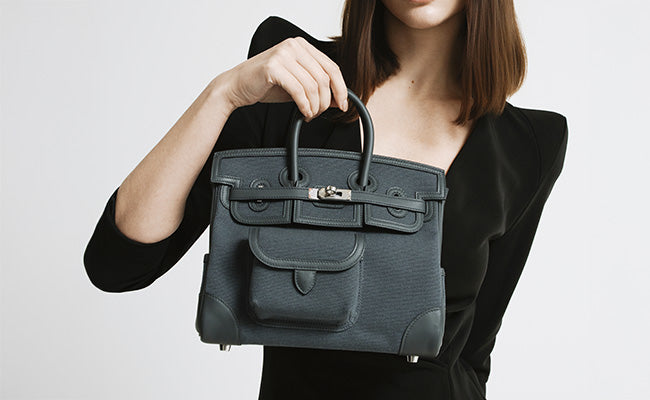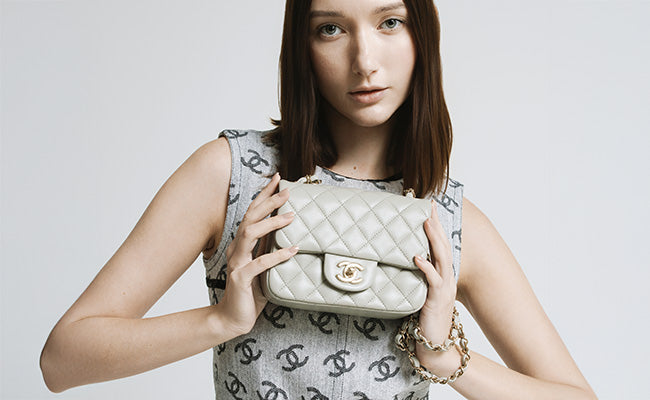
Leveraging Store Credit: Strategies to Upgrade to a Grail
Check out our Hermès collection and Birkin bags!
Every luxury collector knows the rush of spotting your grail piece. Maybe that Hermès bag you’ve been dreaming about, only to see a price tag way out of reach.
Store credit programs have quietly changed the game, letting us approach these dream buys with more strategy than ever before , though the exact terms can vary depending on the retailer.
Store credit systems let you use your current luxury pieces as stepping stones toward grail-level purchases. Instead of letting a starter Evelyne collect dust or selling it for less than it’s worth, more collectors are using trade-in credits to close the gap between entry-level and those elusive quota bags.
The ultra-luxury market isn’t just about cash anymore. The best upgrade paths now blend timing, market savvy, and shrewd credit stacking to make even $30,000+ Birkins seem within reach.
Key Takeaways
- Trade-in programs turn your existing luxury pieces into store credit (often 60-70% of retail) for immediate upgrades
- Timing trades around peak seasons and inventory refreshes can bump up credit offers by 10-15%
- Building rapport with reputable dealers through credit programs can get you early access to incoming grail pieces
Understanding Store Credit and Its Role in Luxury Shopping
Store credit acts as a financial bridge, turning returns into actual opportunities. Luxury retailers use these credits to keep cash flow strong while giving us more flexible routes to our grail pieces.
What Is Store Credit in the Luxury Space?
Store credit in luxury retail doesn’t work like it does at Target. When you return a Hermès scarf or LV wallet, boutiques usually offer store credit, not a cash refund.
These credits keep the full value of your original purchase. Unlike mass retailers, luxury brands know their products hold real value.
Premium store credits often offer:
- No expiration dates
- Transferability to family
- Ability to combine with other payment types
- Access to exclusive or limited pieces
Luxury online stores have adapted too. Now, you can stack credits from multiple returns and use them for bigger buys.
Types of Store Credits: Refund, Gift Card, and Loyalty Point
Refund Credits show up when you return items. Luxury brands usually give these at full purchase value, so your money stays in play.
Gift Cards are prepaid credits. Sometimes, luxury retailers tack on bonus value during promos, handy for building up grail funds.
Reward Points add up with purchases and convert to store credits. Some programs boost earning rates on certain categories or during special events.
| Credit Type | Best For | Typical Value |
|---|---|---|
| Refund Credits | Immediate exchanges | 100% of return value |
| Gift Cards | Strategic saving | Face value + potential bonuses |
| Reward Points | Long-term accumulation | Variable conversion rates |
Key Benefits for Grail Seekers
Store credits help you skip the headache of saving up cash for upgrades. Instead of waiting months to afford that Birkin or Kelly, you can use credits right away.
Strategic advantages:
- Preserve your buying power on returns
- Combine credits for bigger purchases
- Tap into seasonal sales with stored value
- Strengthen relationships with sales associates
Credits also come in handy during limited releases. When that must-have piece drops, you’re ready, no scrambling for payment or missing out.
Luxury ecommerce stores sometimes give extra perks to credit holders, like early access to collections or pieces that aren’t available to cash customers.
Upgrade Pathways: Moving from Starter Pieces to the Grail
Smart store credit moves can turn basic purchases into grail pieces through calculated trade-ins and exchanges. Knowing how retailers structure their programs helps you get the most value and work around their return policies.
Smart Use of Store Credit for Trading Up
Store credit is your best friend when you play upgrades right. Instead of cash refunds, store credit often gets you better value inside the same retailer’s system.
Key timing moves:
- Spend credit during seasonal sales for max impact
- Stack with new customer promos if you can
- Watch those return windows (usually 30-90 days)
Let’s say you get $2,000 in store credit for returning a starter bag. You can put that toward a $4,500 piece during a promo. Some retailers even tack on bonus percentages.
Tips for maximizing credit:
- Keep original packaging: Dust bags, cards, everything
- Maintain condition: Store items well to avoid value drops
- Save documentation: Receipts, purchase records
People have successfully moved from canvas to leather goods using this approach. The trick is knowing each retailer’s credit policies and jumping at the best shopping windows.
Trade-In Programs versus Store Credit
Trade-in programs and store credit serve different purposes. Trade-ins usually give you 30-70% of original retail value, while store credit from returns often gives you the full price (if you’re within the window).
Trade-in perks:
- No rush, return policies don’t apply
- Good for older buys past return windows
- Sometimes accept items from other retailers
Store credit perks:
- Full value (usually 100% of purchase price)
- Ready to use for new purchases
- No need for appraisals or condition checks
Which route works best? It depends on timing and item condition. Recent, pristine buys favor store credit. Older or worn pieces do better through trade-ins.
Get written valuations for both. Some retailers match competitor trade-in offers, so don’t be afraid to negotiate. Always check if credits transfer between locations and whether there are fees.
Optimizing the Return and Exchange Experience
Returns and exchanges need a little planning to get the most out of them. Knowing retailer policies smooths out the process.
Prep steps:
- Review policies: Know your windows, condition rules, receipt needs
- Time returns: Plan around new releases
- Gather documentation: Boxes, cards, receipts
Most luxury retailers stick to 30-day return windows, but some stretch to 60-90 days during holidays. Cash refunds usually go back to your original payment, while exchanges give more wiggle room.
Exchange tips:
- Book appointments during quiet times for better service
- Bring backup options to widen your selection
- Ask about restocking or processing fees
It really helps to build a relationship with sales associates. They’ll sometimes give you a heads up on incoming inventory or hold pieces for you during an exchange.
Pro tip: Some retailers offer price adjustments if your item goes on sale during the return window. That can free up extra budget for an upgrade.
Crafting Store Credit Strategies for High-Ticket Purchases
Store credits are game changers when you’re aiming for big-ticket items like Birkins or Kellys. Stack credits and combine them with exclusive offers to bridge the gap between what you have and what you want.
Maximizing Value from Refund-Based Credits
Treat every return as an investment. When you return items, always go for store credit over cash to keep your buying power inside the luxury world.
Track your credits across different platforms. Shopify credits, brand-specific credits, and department store credits all play unique roles in your strategy.
Time your credit use. Many luxury brands offer seasonal collections, and older inventory often gets marked down. Your credits go further during those windows.
Consider the credit multiplier effect, people tend to spend about 50% more than their credit value when redeeming incentives. That works in your favor when you’re eyeing high-ticket pieces.
Stack credits from different sources if you can. Some retailers let you combine store credits with loyalty points, which can really boost your buying power for grail items.
Combining Store Credits With Exclusive Deals
Private sales and VIP events are prime times to spend credits. These exclusive windows often feature pieces you’d never see as a regular shopper.
Watch seasonal sale cycles at luxury retailers. Pre-season sales, year-end clearances, and private events stretch your credits further on those hard-to-get pieces.
Build relationships with personal shoppers, they’ll tip you off about upcoming opportunities and let you know when your credits can unlock limited inventory.
Create credit timing matrices for brands:
- Hermès: Credits shine during leather appointments
- Chanel: Boutique events open doors to exclusives
- Luxury department stores: Private sales multiply credit value
Some platforms run bonus credit promos at certain times. These 10-20% bonuses can make a real dent in the price of high-value purchases.
It’s just more satisfying when credits help you snag your dream piece instead of settling for whatever’s left.
Customer Loyalty and Engagement: Building Relationships via Store Credits
Store credit systems are powerful for building loyalty and keeping customers coming back. These programs turn simple transactions into deeper brand relationships that last.
Store Credit-Driven Loyalty Programs
Luxury retailers are rolling out more sophisticated store credit programs, not just simple refund policies. These reward you for all kinds of engagement along your shopping journey.
Registration and engagement rewards give credits for making an account, following on social, or signing up for newsletters. It’s a smart way to hook potential customers early.
Feedback and review incentives hand out credits for leaving reviews or filling out surveys. This works especially well in luxury, where authentic testimonials matter.
Referral bonuses reward both the existing and new customer with credits, but only after the referred person makes a purchase.
| Action Type | Typical Credit Value | Engagement Impact |
|---|---|---|
| Account Registration | 5-10% of average purchase | High initial engagement |
| Product Review | $25-50 credits | Ongoing content generation |
| Social Media Share | $10-25 credits | Brand awareness expansion |
| Friend Referral | 10-15% credit value | Customer acquisition |
Reward Points and Tiered Incentives
Tiered loyalty systems give customers a reason to keep spending. The idea is to make moving up feel achievable, and worth it.
Entry-level tiers usually offer 2-3% back in store credits. It’s a gentle intro to the system.
Mid-tier perks might include 5-7% back, early sale access, or bonus events. Lots of customers shoot for these perks.
VIP tiers bump credits to 8-12% and offer premium services, think personal shopping or invite-only events. The highest levels really do foster brand loyalty.
Gamification progress bars, bonus challenges, milestone celebrations, makes earning credits more fun and keeps people engaged.
The key? Make tier progression feel natural, not forced. Set spending thresholds that match real customer habits and offer perks that feel genuinely rewarding.
Encouraging Repeat Luxury Purchases
Store credits are great for encouraging repeat buys, especially in luxury, where shopping cycles can be long. There are a few ways to maximize this effect.
Purchase-triggered credits automatically reward customers with 3-8% back. These credits often expire, nudging people to come back sooner.
Seasonal bonus campaigns up the credit rates during holidays or new launches, making those times especially appealing.
Wishlist integration triggers targeted credit offers when a saved item goes on sale or comes back in stock. This personalized touch really boosts conversion rates.
Inactive customer reactivation adds bonus credits to dormant accounts and sends gentle reminders. Oddly enough, a decent chunk (maybe 15-25%) of inactive customers return within two months after getting those credits.
Cross-category incentives encourage customers to try something new by offering bonus credits for purchases outside their usual categories. It’s a clever way to increase customer lifetime value and broaden engagement.
Optimizing the Store Credit Experience in the Ultra-Luxury Market
Ultra-luxury retailers need to nail their store credit systems. Payment flexibility and smart gifting features can turn routine transactions into real relationship builders.
Seamless Payment Methods and Redemption
Payment should feel as smooth as slipping into a new Birkin. Ultra-luxury customers expect credits to work seamlessly with premium payment methods, Amex Centurion, private banking, you name it.
Redemption should be effortless everywhere. Whether you’re shopping in-store with a personal shopper or browsing online at 2 AM, your credits should apply instantly, no clunky interfaces.
Must-have payment features:
- Real-time credit balance updates
- Partial redemptions with premium cards
- Mobile wallet integration for in-store buys
- Concierge-assisted phone redemptions
Transaction speed is huge. A declined payment or laggy system can ruin the excitement of finally landing that dream piece.
Multiple redemption tiers work well for luxury. Maybe you use credits for small accessories and cash for a major handbag.
Sharable Credits and Gifting as Loyalty Tools
Gifting store credits is a brilliant way to build loyalty networks in ultra-luxury circles. When you can share credits with friends or family, the brand reaches new high-value customers.
Smart gifting options:
- Transferable balances between accounts
- Special bonus credits for occasions (anniversaries, birthdays)
- Referral rewards for both sides
- Exclusive access credits for trunk shows
It just feels special. Getting Hermès store credits is like getting a key to a private club. You’re not just a customer anymore, you’re an insider.
Digital gift cards for luxury brands need to look and feel premium. A plain email won’t cut it when you’re gifting potential Birkin funds.
Customers are happier when gifting is easy and elegant. The experience should match the thrill of unboxing the real thing.
Return Policies and Store Credit: Keeping the Upscale Customer Happy
Luxury shoppers expect top-notch service, even when they’re making returns. The right mix of flexible store credit options and customer-friendly return windows can turn a potentially negative experience into a chance to build lasting relationships with high-value clients.
Returns, Exchanges, and Flexible Store Credit Options
We get it, luxury shoppers want flexibility, not rigid policies. If you’re dropping serious cash on a Hermès scarf or a rare piece, you should have options that respect that investment.
Store credit usually works out better than cash refunds for everyone. Customers stay happy, and the business keeps revenue in-house. There’s even research: about 68% of people spend more than their original store credit when they come back.
Here’s what works best:
- Longer store credit windows at least 12-24 months
- Use your credit anywhere online or in-store
- Partial credits for items with a bit of wear
- Bonus credit maybe 110% of refund value if you choose credit
It’s all about making store credit feel like a perk, not a consolation prize. Pitch it as exclusive access to new collections or early drops. When people feel like VIPs, they see credit as a privilege, not a restriction.
But you’ve got to communicate clearly. Put return policies where people can’t miss them, and make sure staff explain options with some actual enthusiasm.
Designing a Customer-Centric Return Window
Strict time limits can ruin the luxury buying experience. Policies should match how high-end shoppers actually buy.
Luxury shoppers often plan for seasons or special events way ahead. That 30-day window? It just doesn’t cut it if you’re buying a bag for next spring.
More realistic timeframes:
- At least 90 days for full refunds
- 6-12 months for store credit
- No limit for exchanges on unused items
Receipts shouldn’t be a headache. Upscale customers expect us to keep track of their purchases. Digital receipts, loyalty programs, and staff who recognize regulars all help make returns painless.
Gift returns without a receipt? Just offer store credit. Complicated gift returns are a surefire way to annoy luxury shoppers.
Be clear about item condition. "Gently used" should still get partial credit, people want to try things on at home, and that’s fair.
Frequently Asked Questions
Store credit isn’t just a refund, if you know how to use it, it’s a real advantage for Hermès collectors. With the right moves, you can turn credit into those hard-to-get pieces without emptying your bank account or waiting forever.
How can I maximize the value of store credit to step up my Hermès collection game?
Honestly, timing is everything. Use your store credit when new inventory arrives, usually March-April and September-October. That’s when the best pieces hit the floor.
Don’t spend your credit in little bits. Stack it up. A $15,000 balance puts you in Birkin territory, but if you keep using $2,000 here and there, you’ll just collect small stuff.
Get your bags professionally cleaned and authenticated before trading them in. We’ve seen people bump their trade-in value by 20-30% with a good bag spa.
Look for credit bonuses during slow retail months. January and August are quiet, and some consignment shops offer 10-15% extra credit then.
What are the insider tips for using store credit to snag that elusive Birkin?
Spread your credits across several reputable consignment houses. More relationships mean more chances at a Birkin.
Watch those expiration dates! Some collectors have lost thousands by waiting too long for the “perfect” bag.
Ask for notifications about specific Birkins before they go public. High-credit clients sometimes get first dibs, 24 to 48 hours before everyone else.
If you spot a slightly imperfect Birkin within your credit range, consider it. A tiny scratch on a Noir Togo beats waiting another year for a flawless one.
Can you suggest smart ways to combine promotions with store credit for luxury purchases?
End-of-quarter promos are gold, March, June, September, December. That’s when shops try to hit their sales targets and stack deals.
During holidays, look for bonus credits. Black Friday and Boxing Day sometimes mean 15-20% extra on trade-ins.
Loyalty perks can make your store credit go further. Long-term clients often get early access to sales or special markdowns.
Sometimes, adding a scarf or small leather good to your main purchase can get you over the threshold for a better credit multiplier.
Share some savvy advice for transferring store credit into investment-worthy pieces, will you?
Spend credits on classic colors and sizes, Noir, Gold, Etoupe, and standard sizes like 25cm or 30cm. They hold value and sell fast.
Exotic leathers like crocodile or ostrich require more credit up front, but they usually appreciate 10-15% each year if you choose wisely.
Go for limited runs. Scarcity drives up value, so use credit on pieces with low production numbers, not just seasonal stuff.
Condition matters a lot for investment pieces. If you’re buying to resell, pay for pristine bags with all the documentation, not just “good enough.”
How do aficionados use store credits to get ahead of the waitlist for limited edition items?
Show you’re serious by using your credit regularly. Consignment shops notice when you’re a repeat buyer, not just browsing.
Pre-register for upcoming collections and let them know you’ve got credit ready to go. Shops prioritize clients who can pay on the spot.
Keep enough credit in your account during big release periods. Limited editions go fast, and you’ll need to act immediately.
Stay connected with other collectors. Sometimes, word of a limited release gets around before it’s public, and having credit ready lets you jump on it.
Got any clever tricks to flip store credit into a statement piece that'll turn heads at The Ritz?
Rare color combos spark conversations that regular pieces just don't. Rose Shocking or Vert Criquet Birkins? Those always draw a glance or two at luxury spots.
Hardware tweaks make a classic feel fresh. Brushed palladium or rose gold hardware on a Kelly? That subtle difference sets it apart from the usual.
There's just something about vintage Hermès. If you can snag a 1960s Kelly in Box leather with your credit, it'll get way more attention than anything new off the shelf.
And then there's size. Go tiny with a Birkin 20cm or big with a 40cm, the extremes really pop against the sea of standard 25s and 30s at high-end events.
Note: Store credit policies vary by retailer.




